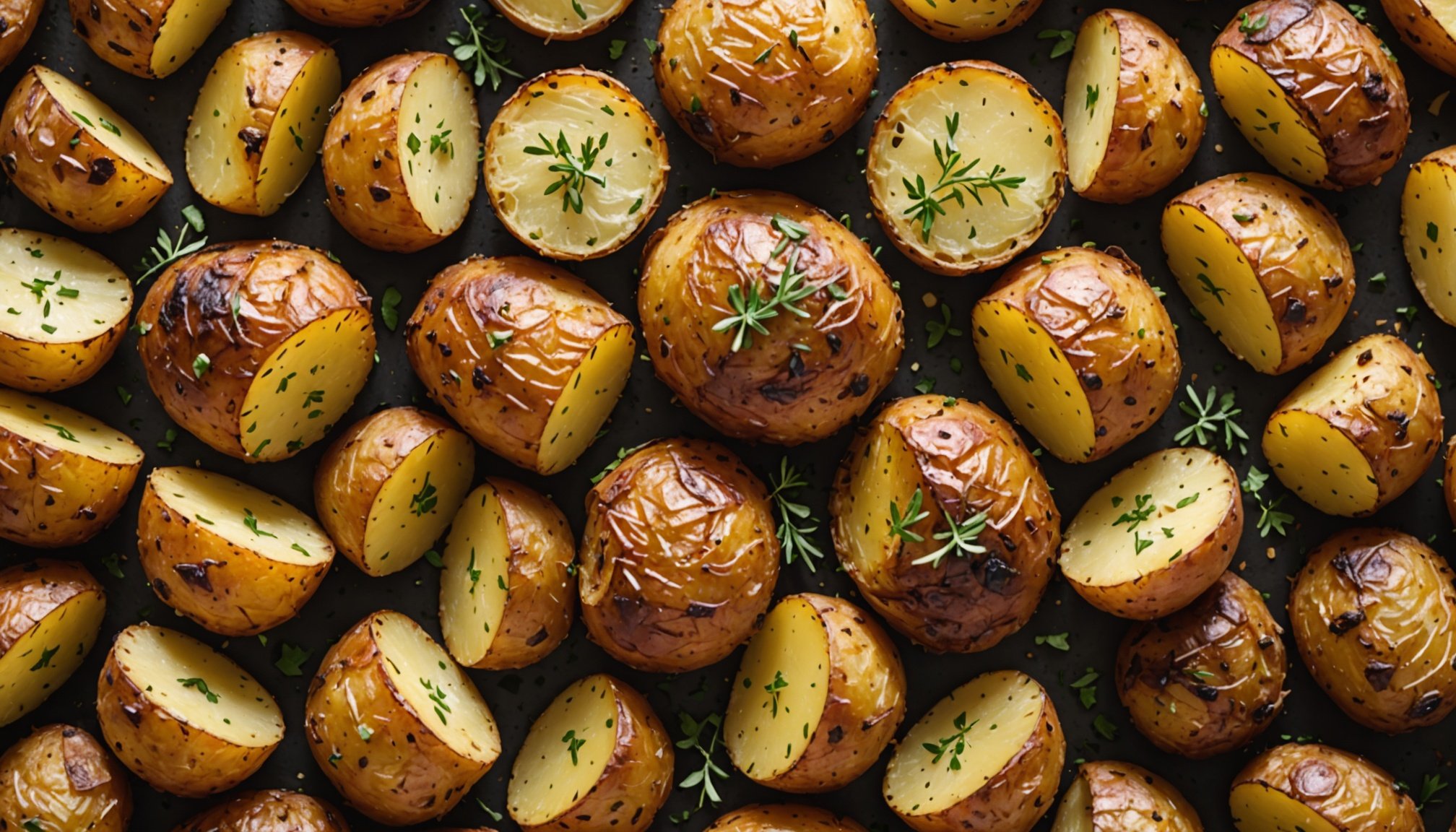Understanding the Basics of English Roast Potatoes
English roast potatoes hold a cherished place in culinary history and are celebrated for their unique crispiness and flavour. Originating from traditional British Sunday roasts, these crispy potatoes have become a staple in many homes, signifying comfort and tradition. The roots of these beloved potatoes can be traced back to simplistic cooking practices aimed at achieving a golden, crispy exterior and soft interior, exemplifying the perfect balance of textures.
To achieve such perfection, understanding the cooking basics is essential. The hallmark of a perfectly cooked roast potato is its crispy, crunchy crust paired with a fluffy interior. This combination is achieved through meticulous preparation and cooking techniques. Essential to this process are key ingredients: choosing the right variety of potato, often a starchy kind like Maris Piper, is crucial for the texture. Each step in preparation, from parboiling to the final roasting, is aimed at enhancing that quintessential crispiness. Additionally, the generous use of fats like goose or duck fat contributes to the alluringly golden-brown finish.
In parallel : Unlock the secrets to heavenly creamy english trifle with sherry: your complete guide to perfection!
Summary of key traits for great English roast potatoes include:
- Golden-brown, crispy exteriors
- Fluffy, soft interiors
- Utilization of starchy potatoes and high-quality fats
Preparation Techniques for Perfect Roast Potatoes
To achieve roast potatoes with the ideal texture and taste, every step in preparation is crucial. Here we delve deeper into the details, ensuring each element is optimised for perfect results.
Also read : Elevate your grilling game: expert tips for a flavorful halloumi delight with lemon and mint
Choosing the Right Potatoes
The variety of potato you choose plays a significant role in achieving the desired outcome. Floury potatoes are often recommended because they produce a fluffy interior and a crisp exterior once roasted. Varieties such as Maris Piper or King Edward are popular choices. These potatoes have a high starch content, which contributes to their textural excellence when roasted.
The Importance of Peeling
Peeling potatoes is more than just removing the skin; it influences the final texture. Proper peeling techniques not only aid in achieving a uniform roast but also ensure the potatoes absorb flavours evenly. Completely removing skin allows for an unobstructed surface, leading to a more consistent crispness across each piece.
Parboiling Process
Parboiling is a vital step that shouldn’t be overlooked. This process involves boiling the peeled potatoes briefly before roasting. Timing is critical; aim for a slight softening of the edges without cooking them through, as this helps form the delicious crispy exterior during roasting. Sufficiently parboiled potatoes drain well and roughen slightly, ready to be coated in your choice of oil or fat for roasting.
Cooking Methods for Crispy Perfection
Achieving crispy perfection in cooking can be an art form. The method chosen often influences the dish’s texture and flavour profoundly.
Oven Roasting
A popular technique is oven roasting. For many, this involves carefully considering the oven settings. Utilizing convection settings over standard settings can enhance browning and even cooking by circulating hot air around the food. For instance, when roasting vegetables, an ideal temperature and time usually involve setting the oven at 200°C (392°F) for around 20-30 minutes, ensuring crispiness while maintaining juiciness inside.
Alternative Cooking Techniques
There are various alternative cooking techniques to explore beyond traditional roasting. Frying techniques can offer simplicity and speed while delivering a satisfying crunch. Deep-frying at a temperature of 180°C (356°F) ensures a crispy exterior while the interior remains tender. However, balancing temperature and time is crucial to prevent overcooking.
Another method combining the best of both techniques is air frying, which promises the texture of frying with minimal oil use. This technique often involves less mess and healthier outcomes. Whatever the choice, the ultimate goal remains the same—achieving a delectable crispy finish with minimal effort.
Seasoning and Flavoring
Achieving the perfect balance of crispiness and flavour in your cooking hinges on selecting the right ingredients. For maximum crispiness, utilizing the appropriate oils is essential. Consider using oils such as canola or avocado oil, known for their high smoke points, ensuring your food crisps up without burning.
When it comes to enhancing flavours, the role of herbs and spices cannot be overstated. Herbs like rosemary and thyme pair excellently with meats, infusing them with rich, aromatic tones. Meanwhile, spices such as cumin and coriander can add depth to your dishes, offering a palette of flavours from smoky to slightly sweet.
Particularly significant in seasoning, salt and garlic bring a transformative touch to any dish. Salt elevates flavours, making them more vibrant and pronounced, while garlic offers a robust, pungent taste that complements a wide range of foods. Whether you’re roasting vegetables or grilling meats, these two are fundamental in creating the desired taste profile.
Experimenting with seasoning tips like these enhances your cooking, allowing you to explore a world of flavor variations and personalize dishes to your taste.
Common Mistakes to Avoid
In the pursuit of culinary perfection, it’s easy to stumble into cooking mistakes that can affect the success of even the simplest dishes. One frequent error is overcrowding the roasting pan. When too many ingredients are packed into a single pan, heat distribution becomes uneven, leading to partially cooked and poorly browned food. To avoid this, use a pan that’s large enough or roast in batches to ensure proper airflow and uniform cooking.
Another aspect often overlooked is the significance of patience in cooking. Certain dishes require time to develop their full flavour potential. Ignoring patience in cooking time can result in tough meats or lacklustre flavours. Always adhere to time recommendations, as some dishes simply cannot be rushed without consequence.
Lastly, a critical component in cooking is striking the right balance of moisture and fat. Both elements are essential for taste and texture. Not achieving the right balance can lead to dry, flavourless food or overly greasy dishes. Aim to use appropriate ratios of moisture to fat, tailored to the recipe at hand, to enhance flavours and maintain ideal consistency. With such cooking tips in mind, you can troubleshoot your way to improved dishes.
Serving Suggestions and Variations
Exploring different ways to serve English roast potatoes can enhance their flavours and offer a delightful dining experience.
Accompaniments for English Roast Potatoes
When seeking perfect paired dishes, consider serving these crispy favourites with options that complement their rich taste beautifully:
-
Roast meats, such as lamb or beef, provide a hearty pairing. Their juices blend seamlessly with the potatoes for an indulgent meal.
-
Light vegetable side dishes, like steamed greens or a fresh garden salad, introduce a refreshing contrast to the crispy texture.
Creative Variations to Try
For innovative twists on traditional recipe variations, consider altering preparation methods or seasoning to expand the culinary experience:
-
Swap out the usual olive oil for duck fat or goose fat for a deeper, more luxurious flavour. The slight change creates a richer taste profile.
-
Incorporate different spices, such as smoked paprika or garlic powder, to elevate the flavour profile of your potatoes. Balancing these additions with your main dish spices ensures cohesive meal planning.
Experimenting with these new serving ideas and variations can transform a standard meal into an unforgettable feast. Feel free to improvise based on your preferences and available ingredients, ensuring each meal remains exciting and satisfying.
Visuals and Additional Resources
In the world of cooking, visuals can significantly enhance your culinary skills and understanding. Images and instructional videos offer a dynamic way to learn, capturing techniques that might be difficult to grasp through text alone. For instance, if you’re venturing into a new recipe, consider searching for cooking visuals that demonstrate each step in detail. These can demystify complex instructions, turning daunting tasks into manageable ones.
Instructional videos are even more potent tools, providing hands-on guidance that can be paused and replayed as needed. Many talented chefs and instructors share step-by-step tutorials online, which can be invaluable in helping you master new skills. When selecting videos, look for those that offer clear and concise explanations, focusing on both the “how” and “why” behind each technique.
Additionally, print-friendly recipe cards are essential for easy access in the kitchen. Having a physical copy allows you to concentrate on cooking without the distraction of digital devices. These cards should include key instructions and visuals that support the cooking process, ensuring you have a reliable reference at your fingertips. Employing visuals alongside these resources can transform your cooking experience, making it both educational and enjoyable.











